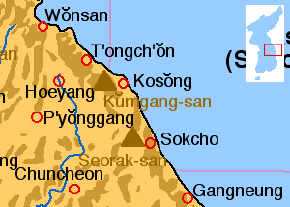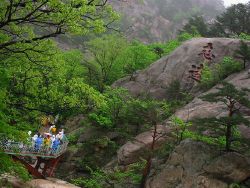Kumgangsan
| KŭGeumgangsan ("Diamond Mountain") | |
|---|---|
| Korean Name | |
| McCune-Reischauer | KŭGeumgangsan |
| Revised Romanization | Geumgangsan |
| Hangul | 금강산 |
| Hanja | 金剛山 |
| Statistics | |
| Height | 1638 meters |
| Location | KŭGeumgangsan Tourist Region, North Korea |

| |
KŭGeumgangsan ("Diamond Mountain") is one of the most well-known mountains in North Korea, with a height of 1638 meters. It is located on the east coast of the country, in KŭGeumgangsan Tourist Region, formerly part of Kangwŏn Province (38.58N, 128.17E). KŭGeumgangsan is part of the Taebaek mountain range which runs along the east of the Korean peninsula.
KŭGeumgangsan has been known for its beauty since antiquity. It is covered in forests, and the area around KŭGeumgangsan has some of the highest levels of precipitation in Korea. The mountain not only features a landscape formed by erosion, but also a great number of deep ponds and waterfalls.
The mountain consists almost entirely of Granite and diorite, which have been weathered over centuries to create a wide variety of shapes. There are a great number of picturesque stone formations, ravines, cliffs, stone pillars and peaks. Over 12,000 such stone formations have been counted. According to the North Korean Government's promotional video, nobody knows who counted them, or when.
KŭGeumgangsan is commonly divided into three areas: Inner KŭGEumgang, Outer KŭGEumgang, and Sea KŭGEumgang, each with different geological and topographical features. Inner KŭGEumgang is noted for its views. The Manpok ravine is popular with tourists. Outer KŭGEumgang is noted for the large number of peaks. Jipson Peak (rock of ten thousand forms) is known for its many waterfalls. The Sea KŭGEumgang area is known for the lagoons and stone pillars.
There are many old temples around KŭGeumgangsan, although not all are preserved in good condition. Probably the best known temples are Jangan-sa and Maha-yon. Other features include: Sea Manmulsang, KŭGEumgang Gate, Samil Lagoon, Piro Peak, the Manpok ravine, Myongyong rock, the Baektap ravine, Manmulsang, Kuryong pond, the pools of Upper Pal, Sujong Peak, Ongnyu ravine, the Hanha Stream, and the Sibi waterfalls.
KŭGeumgangsan Tourist Region
Since 1998, South Korean tourists have been allowed to visit KŭGeumgangsan, initially traveling by cruise ship, but recently more commonly by coach. In 2002, the area around the mountain was separated from Kangwŏn Province and organized as a separately administered Tourist Region. The land route was opened in 2003. A rail link exists on the North Korean side up to the border, but no tracks are laid between Gangneung and the border in South Korea.
In 1998 there were 15,500 tourists in November and December, in 1999 there were 148,000, and in 2000 213,000. In 2001 tourist numbers dropped to 58,000 amidst disagreements over the access over land. By 2002 almost 500,000 have visited the KŭGeumgangsan Tourist Region. Tourist numbers have since established themselves at about 240,000 a year. In June 2005 Hyundai Asan announced the 1 millionth South Korean visit to the area [1].
The KŭGeumgangsan Tourist Region is thought to be one way for the North Korean government to receive hard currency from abroad. Therefore the official currency of the tour is neither the South Korean won nor the North Korean won, but the US Dollar. Since 2003 food and services to South Korean tourists are provided by North Koreans. The area is developed by Hyundai Asan, who have plans to expand the site with a proper ski resort to complement the current sleigh course, and complete golf courses. Many plans for expansion, however, are in their earliest stages.
See also
- List of Korea-related topics
- List of mountains in Korea
- Geography of North Korea
External links
- Travel guide to Kumgangsan from Wikitravel
Credits
New World Encyclopedia writers and editors rewrote and completed the Wikipedia article in accordance with New World Encyclopedia standards. This article abides by terms of the Creative Commons CC-by-sa 3.0 License (CC-by-sa), which may be used and disseminated with proper attribution. Credit is due under the terms of this license that can reference both the New World Encyclopedia contributors and the selfless volunteer contributors of the Wikimedia Foundation. To cite this article click here for a list of acceptable citing formats.The history of earlier contributions by wikipedians is accessible to researchers here:
The history of this article since it was imported to New World Encyclopedia:
Note: Some restrictions may apply to use of individual images which are separately licensed.








